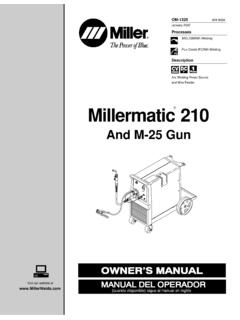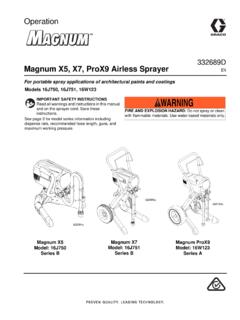Transcription of 1746-UM005B, SLC 500 4-Channel Analog I/O Modules
1 SLC 500 4-Channel Analog I/O Modules (Catalog Numbers 1746-NI4, 1746-NIO4I, 1746-NIO4V, 1746-NO4I, and 1746-NO4V)User ManualImportant User InformationSolid state equipment has operational characteristics differing from those of electromechanical equipment. Safety guidelines for the Application, Installation and Maintenance of Solid State Controls (Publication available from your local Rockwell Automation sales office or online at ) describes some important differences between solid state equipment and hard-wired electromechanical devices. Because of this difference, and also because of the wide variety of uses for solid state equipment, all persons responsible for applying this equipment must satisfy themselves that each intended application of this equipment is no event will Rockwell Automation, Inc.
2 Be responsible or liable for indirect or consequential damages resulting from the use or application of this examples and diagrams in this manual are included solely for illustrative purposes. Because of the many variables and requirements associated with any particular installation, Rockwell Automation, Inc. cannot assume responsibility or liability for actual use based on the examples and patent liability is assumed by Rockwell Automation, Inc. with respect to use of information, circuits, equipment, or software described in this of the contents of this manual, in whole or in part, without written permission of Rockwell Automation, Inc.
3 Is this manual we use notes to make you aware of safety information about practices or circumstances that can cause an explosion in a hazardous environment, which may lead to personal injury or death, property damage, or economic information that is critical for successful application and understanding of the information about practices or circumstances that can lead to personal injury or death, property damage, or economic loss. Attentions help you: identify a hazard avoid a hazard recognize the consequenceSHOCK HAZARDL abels may be located on or inside the drive to alert people that dangerous voltage may be HAZARDL abels may be located on or inside the drive to alert people that surfaces may be dangerous 1746-UM005B-EN-P - June 2004 Summary of ChangesThe information below summarizes the changes to this manual since the last help you find new and updated information in this release of the manual, we have included change bars as shown to the right of this information on:See.
4 SCP (scale with parameters) instruction available with SLC 5/056-3, 6-9, 6-15, 6-21 Change in Impedance to ANL Com specification for NI4 Series B moduleA-1 Change in Impedance Channel to Channel specification for NI4 Series B moduleA-1 Change in Input Impedance specification for NI4 Series B moduleA-4 Change in resistance value for NI4 Series B moduleAppendix DPublication 1746-UM005B-EN-P - June 20042 Summary of ChangesiPublication 1746-UM005B-EN-P - June 2004 Table of ContentsPrefaceWho Should Use this Manual.. P-1 Purpose of this Manual .. P-1 Related Documentation .. P-2 Common Techniques Used in this Manual .. P-3 Your Questions or Comments on this Manual.
5 P-3 Chapter 1 OverviewHow to Use Analog .. 1-1 Types of Analog Modules .. 1-11746-NI4 Analog Input Module.. 1-21746-NIO4I and NIO4V Analog Combination Modules .. 1-21746-NO4I and NO4V Analog Output Modules .. 1-2 Chapter 2 Quick Start for Experienced UsersRequired Tools and Equipment .. 2-1 Procedures .. 2-2 Chapter 3 Installing and Wiring Your Analog ModuleEuropean Union Directive Compliance .. 3-1 EMC Directives .. 3-1 Determining Your Power Requirements for a Modular Controller .. 3-2 Determining Your Power Requirements for a Fixed Controller .. 3-2 Configuring Your Module .. 3-5 Switch Settings for the 1746 NI4.
6 3-5 Switch Settings for the 1746-NIO4I and -NIO4V.. 3-5 External Power Switch for the 1746-NO4I and -NO4V .. 3-6 Choosing a Slot in the Chassis .. 3-6 Installing Your Module .. 3-6 Removing the Analog Module Terminal Block.. 3-7 Wiring Considerations .. 3-8 System Wiring guidelines .. 3-9 Grounding Your Cable .. 3-9 Determining the Cable Length .. 3-10 Wiring the Analog Module.. 3-10 Labeling and Installing the Terminal Block.. 3-12 Grounding the Foil Shields and Drain Wires.. 3-12 Wiring Schematics for 2, 3, and 4-Wire Analog Input Devices .. 3-14 Wiring Schematic for Single-ended Analog Input Connections .. 3-15 Minimizing Electrical Noise on Analog Modules .
7 3-15 Publication 1746-UM005B-EN-P - June 2004 Table of Contents iiChapter 4 Module Operation and System ConsiderationsInterface between the Module and the Processor .. 4-1 Entering Module ID Codes .. 4-1 Addressing Analog Modules .. 4-2 Bit Level Addressing .. 4-4 Processor Update of Analog Data .. 4-5 Monitoring the Input and Output Data .. 4-5 Converting Analog Input Data .. 4-6 Converting Analog Output Data .. 4-7 System Considerations.. 4-9 Safe State for Outputs .. 4-9 Retentive Programming Option.. 4-9 Retentive Analog Output Example .. 4-10 Non-Retentive Analog Output Example.. 4-11 During a Mode Change or Power Cycle.
8 4-11 Input Out-of-Range Detection.. 4-11 Response to Slot Disable .. 4-13 Input Response to Slot Disable .. 4-13 Output Response to Slot Disable .. 4-13 Input Channel Filtering .. 4-14 Chapter 5 Testing Your ModuleTesting the SLC 500 System .. 5-1 Start-up Procedures .. 5-1 Inspect the Analog Module.. 5-2 Disconnect Prime Movers (Motion Devices) .. 5-2 Power Up the SLC 500 System .. 5-3 Testing Analog Inputs .. 5-4 Testing Analog Outputs .. 5-6 Chapter 6 Programming ExamplesAddressing, Out-of-Range Detection, and Scaling of Analog Inputs.. 6-1 Calculating the Linear Relationship .. 6-2 Calculating the Out-of-Range Flag Using the Scale Instruction.
9 6-3 Using Standard Math .. 6-4 Using the Scale (SCL) Instruction .. 6-6 Using Scale with Parameters (SCP) Instruction.. 6-7 Addressing and Scaling Outputs.. 6-8 Calculating the Linear Relationship .. 6-8 Using Standard Math .. 6-10 Using the Scale with Parameters (SCP) Instruction .. 6-12 Scaling Offset when > 32,767 or < -32,768 .. 6-14 Calculating the Linear Relationship .. 6-14 Publication 1746-UM005B-EN-P - June 2004 Table of Contents iiiCalculating the Shifted Linear Relationship .. 6-15 Using Standard Math .. 6-16 Using the Scale with Parameters (SCP) Instruction .. 6-18 Scaling and Range Checking and Analog Inputs and Outputs.
10 6-20 Calculating the Linear Relationship .. 6-21 Using Standard Math Instructions .. 6-22 Scaling and Range Checking of Analog Inputs and Outputs .. 6-24 Using SCL Instruction .. 6-25 Using the Scale with Parameters (SCP) Instruction .. 6-26 Chapter 7 Maintenance and SafetyPreventative Maintenance .. 7-1 Safety Considerations When Troubleshooting .. 7-2 Appendix ASpecificationsAnalog Modules Specification .. A-1 General Specifications for NI4, NIO4I, NIO4V, NO4I, and NO4V .. A-1 General Analog Input Specifications for NI4, NIO4I, and NIO4V .. A-2 Current-Loop Input Specifications for NI4, NIO4I, and NIO4V .. A-3 Voltage Input Specifications for NI4, NIO4I, and NIO4V.
















